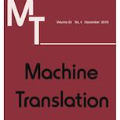In Neural Machine Translation (and, more generally, conditional language modeling), the generation of a target token is influenced by two types of context: the source and the prefix of the target sequence. While many attempts to understand the internal workings of NMT models have been made, none of them explicitly evaluates relative source and target contributions to a generation decision. We argue that this relative contribution can be evaluated by adopting a variant of Layerwise Relevance Propagation (LRP). Its underlying 'conservation principle' makes relevance propagation unique: differently from other methods, it evaluates not an abstract quantity reflecting token importance, but the proportion of each token's influence. We extend LRP to the Transformer and conduct an analysis of NMT models which explicitly evaluates the source and target relative contributions to the generation process. We analyze changes in these contributions when conditioning on different types of prefixes, when varying the training objective or the amount of training data, and during the training process. We find that models trained with more data tend to rely on source information more and to have more sharp token contributions; the training process is non-monotonic with several stages of different nature.
翻译:在神经机器翻译(以及更一般的有条件语言模型)中,目标符号的生成受到两类背景的影响:目标序列的来源和前缀。虽然许多尝试都试图了解NMT模型的内部运行情况,但没有一项尝试明确评价相对来源和针对对一代人决定的贡献。我们争辩说,可以通过采用一种不同的图层相关性促进(LRP)来评估这一相对贡献。其基础“保护原则”使相关传播变得独特:不同于其他方法,它评价的不是抽象数量,反映象征性重要性,而是每个象征影响的比例。我们将LRP扩大到变异器,并对NMT模型进行分析,明确评价源和目标相对于生成过程的相对贡献。我们分析这些贡献的变化,以不同种类的预构件为条件,在不同的培训目标或培训数据数量不同时,以及在培训过程中。我们发现,经过更多数据培训的模型往往依赖来源信息,而具有更精确的象征性贡献;培训过程是非流动的,具有不同性质的若干阶段。




